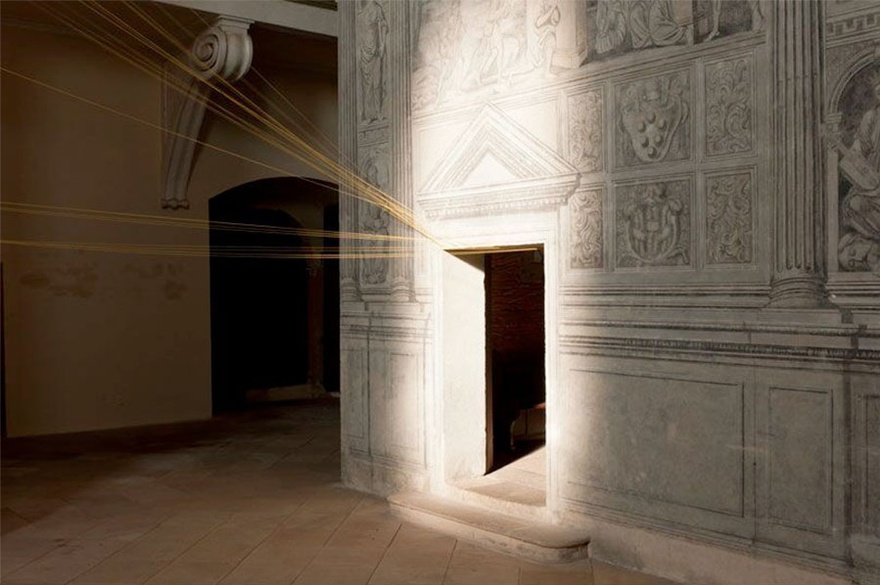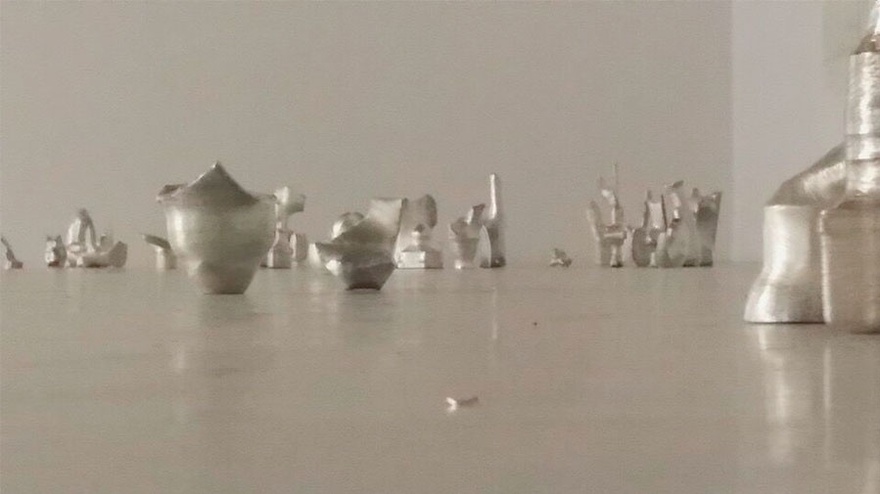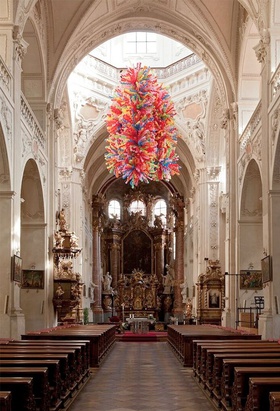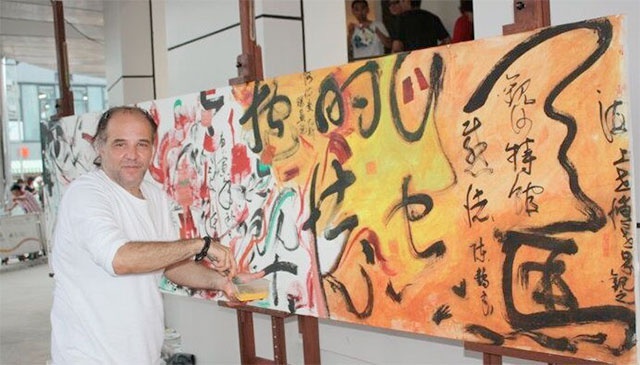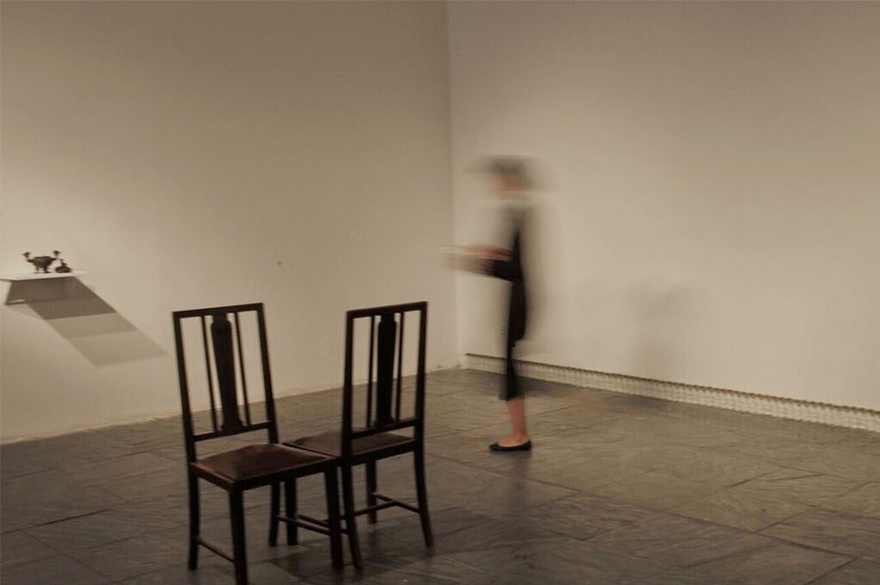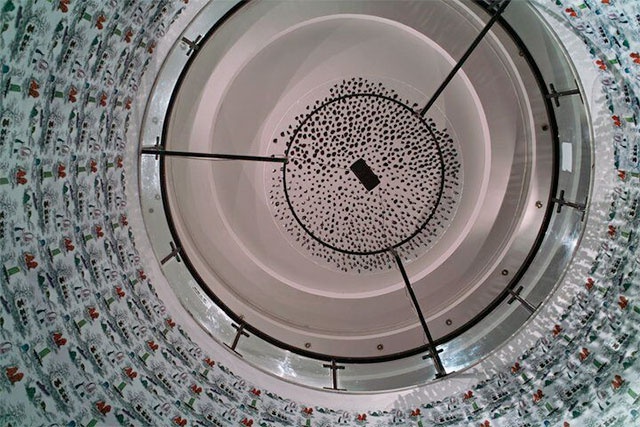Interviews
Between Middle and East
JW Stella in conversation with Aimee Dawson
In this conversation, curator JW Stella describes her experiences working between Asia and the Middle East, particularly South Korea and the Gulf region. As the International Associate Curator for Shanghai Duolun Museum of Modern Art and a regular contributor to Seoul Art Guide, Stella has worked to introduce contemporary art from the Middle East to a wider public in Asia and vice versa. For this reason, in her practice, Stella focuses on the complex issues of visually representing the idea of region-specific, collective cultures and identities. Establishing the long history of communication between the Middle East and Asia, Stella explains the recent trend in connecting the arts of the two regions; discusses the issues of regional shows and the problematic of visualising national identity; and questions the developing cultural infrastructures of the two regions.
Aimee Dawson: You've been working between the Middle East and Asia for the last decade, including projects such as the Saudi Arabian contemporary art exhibition for the 2010 Shanghai World Expo at the Shanghai Duolun Museum of Modern Art in China, NABATT: a sense of being; the exhibition [ana]: Please keep your eyes closed for a moment at Maraya Art Centre in Sharjah (2015); and most recently working with the Asia Culture Center, Gwangju, Korea and the International Curators Forum in London on a travelling symposium 'Curating The International Diaspora', which travelled to Barbados and Martinique last November and will head to Sharjah for the Marching Meeting in March. In the last ten years there has been a great deal of development both within and between the Middle East and Asia, in terms of political, commercial and infrastructural changes. Could you briefly trace and comment on this developing relationship? What do you think has fuelled it? How do you see it developing in the future?
JW Stella: Yes, there has been a socio-political, economic and cultural re-union between the Middle East and Far East in the last decade especially. The reason that I call it a 're-union' is because these engagements started long before most people think – the first encounter between the 'Middle East' and the 'Far East', although I am not in favour of using these geopolitical terms, was around 200 BC through the Silk Road, although the geographical terms were different back then. Since this period, there has been a great deal of hybridization in culture, flow in migration, propagation of religions, and development of economy and science across the countries and between the two regions.
In Korea for instance, Hyecho, the renowned Buddhist monk from the Shilla Dynasty (57 BC–935 AD, Korea), wrote the eighth century travel essay entitled 'Wang ocheonchukguk jeon' with a vivid description of Arab and Persian society and their lifestyles at the time. The Persian geographer, Abu'l-Qasim Ubaydallah ibn Abdallah ibn Khordadbeh (820–912 AD), also wrote about 'Arabs settling in Shilla' in his book, titled The Kitab al-Masalik wa l-mamalik (The book of itineraries and kingdoms). These two references are the first instances of Korean-Arab and Persian relations being mentioned in publications – they were around 700 years before Marco Polo (1254–1324) mentioned Korea in his travel essay 'The Travels of Marco Polo' (1276–91). In fact, Gyoungju's (the old capital of Shilla) national museum has some collections with historical artefacts that demonstrate the cultural engagements between Arabs, Persians and Koreans.
A new Silk Road is in the process of being re-developed and although it is mainly for economic and commercial purposes, art and culture always follow. The contemporary art exhibition NABATT: a sense of being, that I co-curated for the Shanghai World Expo in 2010 with the Shanghai Duoln Museum of Modern Art was about Saudi Arabian modern and contemporary life, literature and music and it can be considered as the first platform for art from the region in a public art museum in East Asia. Qatar Museums also hosted China last year in their 'Year of Culture' programme, organizing various exhibitions and talks, such as What About the Art? Contemporary Art from China, curated by Cai Guo-Quiang. Institutions in Sharjah, UAE, such as Maraya Art Centre and Sharjah Art Foundation, are also actively engaging with those of Korea, including the Seoul Foundation of Art and Culture, the Asia Culture Centre in Gwangju, the Korea Arts and Culture Education Service and the National Museum of Modern and Contemporary Art (MMCA), Korea.
These art and cultural cross-polinations are definitely fuelled by economic and political engagements and developments. However, as a cultural practitioner, I think those conditions are just a matter of practicality. It is more about creating a critical space for debating the various notions of collective cultural identities across pan-Asia that have been, and will continue to be, very active within Asia.
AD: As you mention, there seems to be a pattern of Middle Eastern art institutions starting dialogues with the East and vice versa. While this year the focus is on China, Qatar also partnered with Japan for their year of culture in 2012. In 2015, Crossway Foundation and Edge of Arabia organized a cultural and artistic artist trip for eight young creatives from Saudi Arabia, the UAE, Kuwait and the UK to go to Japan to collaborate with local arts organisations. In 2012, the Mori Art Museum in Tokyo held the exhibition Arab Express: The Latest Art from the Arab World, which featured 34 artists from the Middle East and was the first exhibition of its kind to be held in Japan. Why do you think this is?
JWS: It's true and there are a lot more examples: as well as the exhibitions you've mentioned there was also Yoshimoto Nara's solo show, which was the special exhibition of the Cairo Biennale in 2010; the inspiring artist duo Young-hae Chang Heavy Industries who were shown at the Jerusalem Show in 2011; and there were many Asian (and Asian diaspora) artists, such as Min Jeong Seo, Kim Beom, Shiro Takatani, Simon Fujiwara, Haegue Yang and Yang Fudong, introduced through various exhibitions in Beirut and Sharjah (the Home Works 6 exhibition in Ashkal Alwan in 2013 and Sharjah Art Biennale in 2013 and 2015 respectively.). And this inclination continues – the thoroughly researched retrospective show of Yayoi Kusama curated by Hoor Al-Qasimi opened last October at Sharjah Art Foundation.
Meanwhile, the artists from the MENA region such as Hasan Kahn, Akram Zatari, Basel Abbas and Runne Abou-Rahme, Lawrence Abu Hamdan and many more artists from the MENA region have been introduced to Korean audiences through various exhibitions in Korea. Artists Mohamad Kazem and Ghada Da have participated in the residency exchange programmes in Korea through Maraya Art Centre, and in 2017 When Art Becomes Liberty: The Egyptian Surrealists (1938-1965) exhibition, co-curated by Hoor Al Qasimi, Salah M. Hassan and Ehab Ellaban will travel to Korea and the MMCA's artist residency program called 'Changdong' is hosting artists from UAE and Iran. Small institutions collaborate with each other too – it keeps on growing! There are various reasons for this growing interaction and I'm not in a position to state all the motives for each show or residency. Whether transversal or transnational, however, it is certain that the current climate of the international art world is changing.
AD: Do you think that the East-Middle East connection works to reject the western-dominated art world, where London, Paris and New York are seen as the standard global art hubs? Do you think there is a move towards actively subverting this structure?
JWS: It is not necessarily a rejection but a correction. As Edward Said stated, the notion of 'Asia' is a ghostly identity created and imagined by the West – we have been identified by the West rather than asserting ourselves. Since the two critical exhibitions Magiciens de la Terre (1989), curated by Jean-Hubert Martin, and The Other Story: Afro-Asian Artists in Post-War Britain (1989), curated by Rasheed Araeen, the notion of 'otherness' in the western art world has been in continuous debate, under many contexts such as orientalism, post-colonialism, post-modernism, globalism, and glocalism. We all know that the art world has shifted towards the transversal and transnational, making people believe that the idea of Euro-American centric art no longer exists. Having said that, we cannot deny that we are facing the reality that art from not only Asia, but also any non-Western regions has been, and still is, often identified or even branded under ethnic terms.
In the present global art world, the numerous cultures that belong to the term 'non-western' must free themselves from an idea of exoticism and be able to ascertain their own cultural identities – this entails extensive research and multi-disciplinary collaboration in the field of history, anthropology and sociology. Contemporary Asia is in a state of flux and I see the East-East connection as another great step forward in the history/histories of contemporary art.
AD: Your latest exhibition, [ana]: Please keep your eyes closed for a moment at the Maraya Art Centre in Sharjah (21 October 2015–2 January 2016), was the first exhibition of contemporary Korean art at a public institution in the Middle East. It featured works by 12 young Korean artists, including Yeesookyung, Juyeon Kim, Hong Soun and Theresa Hak Kyung Cha, as well as one artist from Saudi Arabia, Ghada Da. How did this show come about?
JWS: The idea to introduce contemporary art from South Korea had been discussed with Maraya Art Centre since November 2012 when I visited the UAE to write about the contemporary art scene there for a Korean art journal. At that time, Maraya was a relatively young art institution and yet very progressive and open to new ideas, particularly when it came to international cultural collaborations and engagements. Since contemporary art from South Korea was relatively unfamiliar to the MENA region in comparison to those from China or Japan at that time, Maraya and myself were very excited about introducing this scene.
AD: The idea of a group show based on nationality or regions is often perceived as problematic, in that they seem to deny the artistic work and process and reduce it to a kind of fetishism about a specific culture. This has often been the argument when 'Arab' art is shown in exhibitions aimed at 'surveying' the scene. What do you think about this?
JWS: The matter of art being overshowed by the notion of cultural identity is such a contradictory question and is even lacking in ethical significance when one considers how cultural identity is now increasingly invoked to support the political claims of individuals and exploited as a notion of national character. According to Dr. Btihaj Ajana from Kings Collage, London, who participated in the UN ID2020 Summit in New York last May, there are approximately 1.5 billion vulnerable populations currently living without a recognised legal identity. How could we account for this moral ambivalence when it comes to the ecology of art exhibitions, especially international exhibitions, which are legally and politically biased cultural activities? How could we include these 1.5 billion people as audiences and artists in this so-called 'cultural activity'? The most important matter here is that art should play a role in breaking through these ghost-like socio-cultural clichés - or cultural fetishism as you said.
When it came to developing the curatorial concept for [ana]: Please keep your eyes closed for a moment, I wanted to focus on the long-term subject and dilemma of my curatorial practice, which is the notion of a 'collective identity' – namely Ibn Khaldun's term 'asabiyyah' in Arabic (meaning the bond of cohesion among humans in a group forming community such as tribalism or nationalism) that he introduced in his book Muqaddimah. The notion of collective cultural identitieshas been being percolating through my curatorial discourse for the last ten years, especially the idea of Asia as being remote from the territory of the West not only in geographical sense but also that of a culture by being excluded from the History of art (History with a capital 'H') and objectified as the antithesis to the West.
Art is part of cultural practice and is therefore often expected to represent one collective cultural, national, ethnic identity: Korean art, Arab art and so on. However, is it fair for an artist, as a free individual, to be positioned under the pressure of representing one culture? Who is defining these identities and based on what elements? Culture is one of the most complicated forms of ecology that exists and is a constantly evolving phenomena, effecting and being effected by people living through the epochs of post-globalization, mass mobility and digital modernity. To that end, for over a century anthropologists have been trying to understand culture, and its absolute definition still remains unanswered. Hence, defining one's cultural identity itself is such a vast question. That's why I brought [ana] into the core part of the curatorial concept of this exhibition; the Arabic term 'ana' means 'I' or 'oneself' in English, whereas it is pronounced as 'na' in Korean. The three words signify the same meaning within semiotics. The signification of the characters, however, can vary in accordance with the different ideologies, paradigms and value systems of the diverse cultures and societies from which they are derived.
AD: As part of your exhibition at Maraya, you also connected the institution to other like-minded art spaces in Korea. As a result, in August 2015 Maraya Art Centre announced an artist residency exchange programme with Seoul Art Space Geumcheon – was creating this collaboration an important part of your curatorial direction and framework for the [ana] exhibition?
JWS: Yes, it was one of my curatorial strategies of this show. I wanted to create a firm platform that enables artists from these two very different worlds to experience and interact with one another by connecting between institutions. I think it's important to build up a stable structure, rather than a one-off engagement. In South Korea we have more than 100 public and private artists residency programmes and Geumchun, which belongs to Seoul Foundation for Arts and Culture, is one of the most active ones, especially for international engagement programmes. I'm very pleased to know that this exchange programme is continuing even after the [ana] exhibition is over.
AD: This is crucial when one considers that formal, state-run education in contemporary arts in the Middle East is notoriously lacking. This issue has also led to the development of private, artist-led programmes across the MENA. What do you think the future is for arts education in the region? Are there any things that can be learnt from other countries you have experience with, such as Korea?
JWS: Yes, there is a great need for educational opportunities for local artists in the Middle East and, therefore, many of the artists have been educated abroad. Personally, in Korea, I was educated in art practices since the age of 11 in a private school for fine art. Ironically though, I am not a big fan of the art education system – like a double-edged sword, it develops your artistic skills but also de-individualizes you by restricting you to the artistic cannons. In 2009–10, when I travelled to Saudi Arabia (Riyadh, Jeddah and Dammam) for my curatorial research for the NABATT exhibition, I met a lot of art communities and groups who were mainly self-taught artists. Most of them had a day job and practiced art at night. The organically grown art scene was very distinctive and authentic from the artistic cannons that I (we all) have become accustomed to in the contemporary art world. At some point, art is not a subject that can be taught by anyone.
AD: The Private Art Museum Report, an international research project calculating the number of private museums in the world, found that South Korea had the highest number of privately funded museums at 45, with America second and Germany third. You have witnessed this burgeoning development of arts infrastructure in Korea. Do you think that this is telling of the state of art funding not only in the Western world but also in the East? Lebanon, for example, has a rapidly developing private museum scene with the Aïshti foundation and the Nicolas Ibrahim Sursock Museum, which opened in 2015, and the partially privately funded National Museum due to open in 2020, among many other projects.
JWS: I was surprised to hear this result about South Korea. It's important to consider that this number doesn't necessarily mean something positive – the important thing is quality rather than quantity. Also, considering the fact that each country has different regulations and requirements for private museums it is very important to make sure that these museums follow the codes of museum ethics. In the East, each country has different cultural policies that determine its state funding situation. In South Korea, for example, our public funding, fortunately, is not as restricted as the ones in the West at the moment. Private museums get partially funded by the local government each year as well.
AD: These museums are often much more popular than state museums because they have the budgets to be able to promote and market their institutions.
JWS: I think it all depends on the financial and curatorial capacities of the museum. In South Korea, very few private museums have big enough budgets to organize and advertise their shows internationally and manage large scale commissioning art works, unless they belong to big corporate companies. I see more of these cases of affluence in China rather than in South Korea because these days the numbers of private mega museums keep on growing while the public contemporary art museums gain less government support.
AD: Do you think the combination of art or culture and private equity, which has led to further commercialization of art, is problematic?
JWS: Art and culture are no longer free from neo-capitalist society and private equity can help to fuel and enrich contemporary art and culture, of course. However, when it comes to running a museum, for instance, something more than monetary qualification is required and it is more to do with a 'moral' issue. The concept and function of a museum should not be abused nor compromised to become a playground for the rich. In this way, the increasing commercialization of art can be rather problematic.
AD: The Gulf has benefitted from oil revenues to build a cultural sector in recent decades although this strategy is in crisis now because of decreasing oil prices. Other parts of the Middle East continue to struggle with little state funding. What is your understanding of how art infrastructures have developed and are developing in the region? Have you ever come across funding struggles in your own work in the region? How does this compare with your experience in South Korea?
JWS: Public funding for the arts is heavily dependent on the GDP of a nation. When a country is facing a deficit it becomes inevitable that a government will have to implement an austerity budget, and money for the arts and cultural sector are always the first to be cut. In that sense, it is not hard to understand the current worries about state funding in the Gulf region. What I have found interesting in the region's art scene though is the fact that private funds and support have become the cornerstone in establishing the structure of the art. It is more than mere sponsorship. These philanthropic gestures and patronage for art in the region were initiated long before the public funds.
The exhibition [ana]: Please keep your eyes closed for a moment at Maraya Art Centre was made mainly with public funds from the Sharjah Investment and Development Authority (Shrooq) with the support of Art Council Korea, and KAMS (Korea Art Management Service) supported my curatorial research as well. The NABATT exhibition was also generously sponsored by the King Abdulaziz Centre for World Culture, HRH Princess Reem Al Faisal Al Saud, Saudi Aramco and Huawei. In South Korea, public grants programmes are open call and the assessment processes are transparent. It is open to all artists and curators and if your proposal fits the requirements of artistic excellency and viability then anyone can benefit from it.
AD: The last five years have been a tumultuous period in the Middle East – for you, what have been the big changes?
JWS: One of the biggest changes is the international awareness of the artists and the art scene in the Middle East. The UAE, for example, has now evolved into the international platform for local and diaspora artists from the MENA region, while the public institutions in the UAE and Qatar have become structured and influential. Beirut is the think-tank of the MENA art scene.
However, I am concerned about the current geopolitical and social circumstances between the Middle East and the West and the rise of 'nationalism' as a dominant discourse, often justified as a sense of self-protection of the people under the same collective identity against 'otherness'. This, as a result, limits understanding, exposure and openness to other cultures, despite the increasing globalization of cultural flows and practices, facilitated by the advent of digital technologies, social media platforms, and the increasing circulation of goods and people. In these circumstances, it is hard to say where we can go from here and what the fundamental role of art would be in easing the situation but it's imperative that we all continue to contemplate it.
JW Stella is the founding director of JW STELLA Arts Collectives, a London based non-profit curatorial research lab. Recently, it has conducted the extensive research and archive project 'Asian Diaspora Art in the UK and Germany', commissioned by the Asia Culture Center, Gwangju, Korea. Stella also works as the International Associate Curator with Shanghai Duolun Museum of Modern Art, the first public contemporary art museum in China. Her curatorial focus is socio-cultural anthropology that examines cultural relativism through contemporary art practices and she also questions the role of art and what it means to be practicing contemporary art in current societies.
Her curatorial practice includes Curating The international Diaspora (Asia Culture Centre, Gwangju, International Curators Forum, London, 2016); [ana]: Please keep your eyes closed for a moment (Maraya Art Centre, Sharjah, UAE, 2015); TIME CAPSULE: Allegories of Shanghai (Shanghai Duolun Museum of Modern Art, China, 2015); [WOO:RI]: interrelationship between you, myself and us, a site-specific contemporary art project in the national and UNESCO cultural heritages in Czech Republic (TINA B. Prague Contemporary Art Festival 2012 and Centre for Theology and Arts-Charles University, Prague, 2012–2013); MY SHOPPING BAG: Allegories of Seoul (2011 London Design Festival, UK); NABATT: a sense of being, the Saudi Arabian contemporary art exhibition for 2010 Shanghai World Expo (Shanghai Duolun Museum of Modern Art, China, 2010); SU:MBISORI – the inaugural international contemporary art exhibition for Jeju Museum of Modern Art (Jeju special self-governing province, Korea, 2009); and USB, an exhibition on Korean diaspora (Hangaram Art Museum in Seoul Art Center, Korea, 2009).

